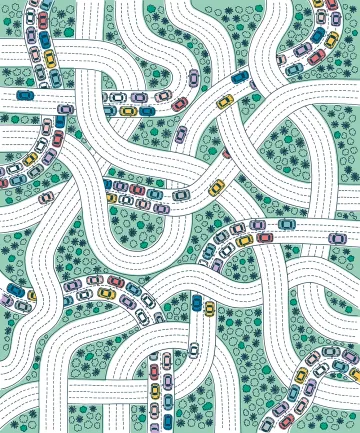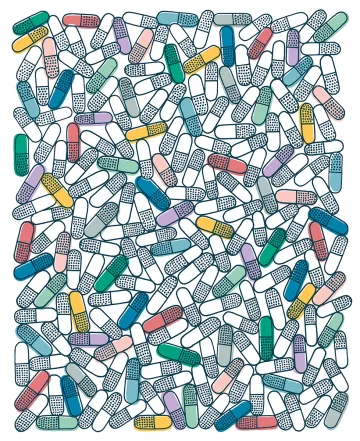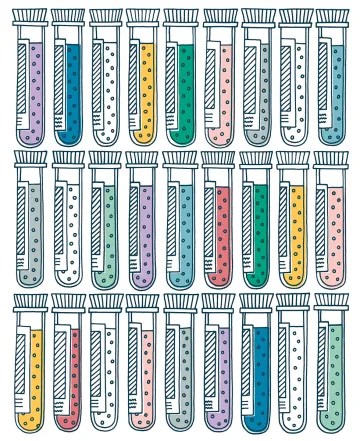Putting Inventions to Work
How the UA Commercializes Its Outstanding Research
New ways of packaging the hundreds of inventions that emerge from the University of Arizona’s $600 million research enterprise and getting them into global markets are shaking up how the UA does business — and getting results.
Out of their academic work of discovery and innovation, UA faculty and staff produce an increasing flow of inventions — 250 in fiscal year 2016. And Tech Launch Arizona has helped start dozens of companies based on those inventions, including technologies like brain chemistry measurement tools, tunable lasers, traffic-flow engineering and new cancer therapies.
TLA helps identify viable UA inventions, protect them with patents and develop strategies to bring them to market. It all happens in a carefully designed ecosystem, says David Allen, the UA vice president who leads TLA.
A vital part of that ecosystem is a commercialization network of 1,400 domain experts and business veterans from across the country. Members of the network, 70 percent of whom are UA alumni, share expertise about market opportunities for UA technologies.
“It’s important for us to get the business community deeply engaged with the research community,” says Allen. “A professor teamed up with a business leader has a better shot at getting financing and addressing the market need. So we say, ‘Let us find the partner for you.’”
Twenty-five of the commercialization partners, whose business contacts run particularly deep, have volunteered to review inventions and share strategies to develop commercial pathways for inventions. Some are executives who worked with TLA to launch their own companies. Four are mentors in residence: successful tech entrepreneurs and leaders with expertise in building startup teams who work with UA professors.
All are among the best at doing business in their specific technical areas. “They are well prepared to help us devise a targeted commercialization strategy for the embryonic company,” says Joann MacMaster, TLA’s director of business development.
Creating startups — companies founded to commercialize a UA technology — is not TLA’s only focus. With advice from its network, it also crafts strategies to license UA technologies to companies looking to expand their offerings. Invention royalties have risen steadily since TLA opened in 2012, from $922,000 in TLA’s first year to over $2 million in 2016, for a five-year total of $7.3 million. The number of new UA startup companies has also risen, from just six in 2012 to 14 in 2016. As of January 2017, the total number of startups was 52.
Those statistics compare favorably with the UA’s peers, and with TLA’s expertise the University is holding its own in other ways as well. For example, in 2015 the UA produced 3.5 invention disclosures per $10 million spent on research, while the University of Colorado Boulder delivered 2.7 and Georgia Tech 4.0. The University of Pittsburgh was the top performer, with 4.3 inventions per $10 million. All told, in comparison to 15 other top public research institutions, the UA ranked eighth in 2015. “Solid performance for such a young program,” Allen says.
One strategy TLA has introduced is embedding licensing managers in the UA’s technology-oriented colleges: medicine, science, optical sciences, engineering, management and agriculture and life sciences.
“Each licensing manager has an office near the faculty,” Allen says. “They spend their time there working for our customer — the faculty member. They can say, ‘I’m down the hall; I’ll pop by your office.’ And when they hear about a new idea, they have two primary considerations: Is it patentable? Is there a market for the technology? Only some of the inventions can make it.”
The strategy appears to be paying off; the average number of licenses issued annually for UA technologies has doubled, from 47 in 2012 to 95 in 2016.
Part of the attraction for professors is getting a share of royalties for their intellectual property, or IP. “When TLA licenses UA IP,” says Paul Tumarkin, the marketing manager for TLA, “the UA makes money from royalties (a small percentage of sales). The royalties are divided among the inventor or inventors, the UA college, the department, even the lab itself. The benefits are shared across the value chain.”
But TLA experts understand that the primary goal of faculty research is not to create products but rather to advance knowledge and understanding.
“Their focus is on research and discovery,” Allen says. “So we bring a whole other group of people to the table to provide input and direction on the commercialization end.”
The TLA ecosystem helps startups take their first steps — a perfect hub of innovation for a research powerhouse like the UA.
Metropia: Smoothing Traffic Snarls
Afew years ago, Yi-Chang Chiu had a lightbulb moment. Since then, his big idea for shrinking traffic jams has become a company with global impact. His story illustrates the help that hundreds of UA professors are getting from Tech Launch Arizona.
In 2011, Chiu’s children faced a long line at a Universal Studios tour and were offered a chance to return later and use an express lane. The principle of being rewarded for making a reservation, he thought, might help reduce vehicular traffic jams — and might just change the world.
Chiu, a UA associate professor of civil engineering and engineering mechanics, knew the tricky algorithms that drive a software platform. What he didn’t know was how to launch a promising company — so he worked closely with TLA.
From TLA he got the first seed funding and a chance to work with his business adviser, Corey Smith, a retired CEO. And the venture took off: TLA filed a patent, wrote up a license agreement in 2012 and helped form Chiu’s startup, called Metropia.

“It was one of the first licenses we managed,” says Joann MacMaster, TLA’s director of business development. “We worked with Metropia through both our incubator and mentor network. And now they are working on more and more deals,” she adds, referring to Metropia’s expansion across the United States and in Asia.
Chiu’s invention involves a smartphone app that tells urban commuters in real time where and when to drive most efficiently. The app offers incentives to drivers if, say, they slightly alter their departure time, take a recommended route, carpool or use other modes.
Municipal and state transportation agencies contract with Metropia to help improve traffic conditions by offering commuters those incentives to make smarter travel decisions and by analyzing the vast amount of anonymous data shared by users.
Chiu compares his technology’s benefits to pouring rice into a funnel. It goes slowly when poured all at once; when poured in small increments, the rice moves more quickly and smoothly. It’s the same, he says, with cars in heavy traffic.
So far, his app is available in Austin, El Paso and Tucson and has attracted tens of thousands of users. It will soon be available in Houston, Phoenix and other U.S. cities and it is in beta testing for New York.
Metropia, which garnered a $15 million valuation in its initial fundraising effort, has 25 employees in Tucson, Austin, El Paso, New York, Los Angeles, Seattle, Taipei and Shanghai.
The startup recently led a team of academics — including some from the University of Arizona — and high-tech companies in partnership with the Texas Department of Transportation Houston District to win an $18 million grant from the Federal Highway Administration and the Texas Department of Transportation to expand in Houston.
In Tucson, the company also led the effort to win a $670,000 federal grant in partnership with the Regional Transportation Authority to collaborate on a Mobility on Demand initiative that will connect citizens with transit alternatives, like community-based carpooling or ride-sharing in the Rita Ranch area.
“Here’s a UA startup, now fully engaged in the community,” MacMaster says. “And its founder is now a member of our commercialization network, advising and helping others. That’s what we hope to see more of.”
SinfoníaRx: Prescription Management for Millions
Perhaps the widest impact of any TLA-aided launch to date is SinfoníaRx, whose services currently reach 1 in 7 Americans.
A few years ago, Kevin Boesen ’96 was an assistant professor in the College of Pharmacy and the inventor of a remarkable UA system for optimizing prescriptions to assure safety and savings for 2 million patients.

Today, Boesen is the CEO of a company that monitors prescription medications for 50 million patients from 350 Medicare, Medicaid and commercial health plans, including most Blue Cross Blue Shield plans. Wal-Mart pharmacies use the technology to manage medications for all customers.
In 2006, Boesen hired a team of pharmacists and software developers to create the sophisticated software. The system was designed to support health plans participating in the Medicare prescription drug benefit launched that year.
The software currently reviews more than 20 million prescriptions weekly. If it identifies a potential concern, specially trained clinical pharmacists reach out to patients and sometimes doctors directly to resolve it.
When he connected with TLA, its experts helped Boesen package his core software to become an attractive candidate for acquisition in the private sector. It was eventually acquired by Sinfonía Healthcare and named SinfoníaRx.
SinfoníaRx, now with offices in downtown Tucson, is flourishing. Boesen, who left the UA to head the new unit, credits TLA with putting him in touch with Tucson entrepreneur Fletcher McCusker, who made SinfoníaRx his fourth local company.
“This would not have happened without TLA,” says McCusker. “The key was the concept of commercializing it, letting it go private. Like Gatorade spinning off from the University of Florida, this shows how universities can benefit by putting an idea in the private sector.”
The company continues to give UA students roles as interns in medication management and in research projects. At the UA, the Medication Management Center employs about 200 people who provide call center services under contract to SinfoníaRx, including nearly 60 full-time pharmacists and pharmacy technicians and 150 student workers. SinfoníaRx also operates similar medication management centers in Phoenix and Florida and at Ohio State University in Columbus.
Synactix and Promutech: an Assault on Cancer
As a grad student working on treatments for rare cancers, Brendan Frett had great ideas for marketable cancer drugs.
“I had found some interesting compounds with unique properties that made them good candidates for commercialization as drugs for a specific cancer,” Frett says.

He connected with a TLA adviser and things clicked. Before long, Frett was CEO of two new pharmaceutical companies that grew directly out of his doctoral dissertation work, one of which is Synactix Pharmaceuticals.
Synactix — the name refers to synergy plus action — has acquired a license to use Frett’s cancer treatment technology, which involves a kinase inhibitor that treats cancer by a multi-target, single-agent strategy that simultaneously starves and kills malignant tumor growth.
The traditional “one drug, one target” approach fails to treat many diseases, Frett says, and he prefers a “one drug, strategic targets” tactic, known in pharmacy as single-agent polypharmacology.
Synactix plans to work with the M.D. Anderson Cancer Center in Houston for the clinical stage of drug development, and the company recently formed a partnership with Chongqing University of Arts and Sciences in China to do development work on the product — work that Frett estimates is worth about $2.5 million.
Toward the effort, Frett’s team was awarded federal Small Business Technology Transfer grants worth nearly $340,000 for Synactix and more than $285,000 for his second company, Promutech, for preclinical work.
For all that, he tips his hat to TLA. “They were very helpful to ensure our progress,” Frett said. “They put me in contact with the right people locally and nationally.”
